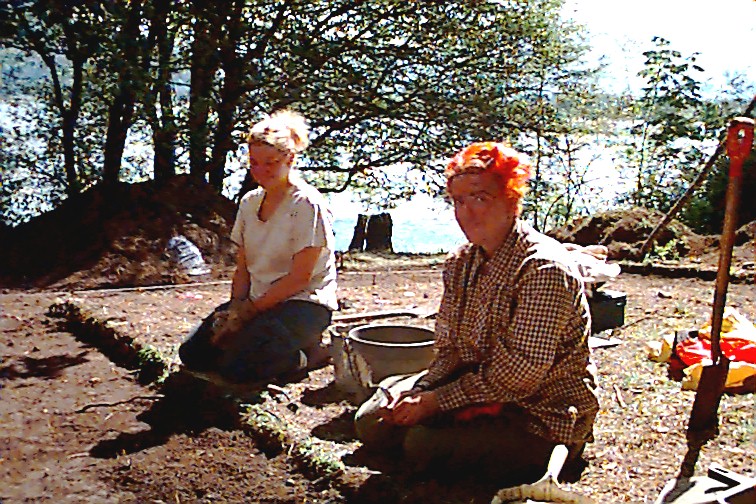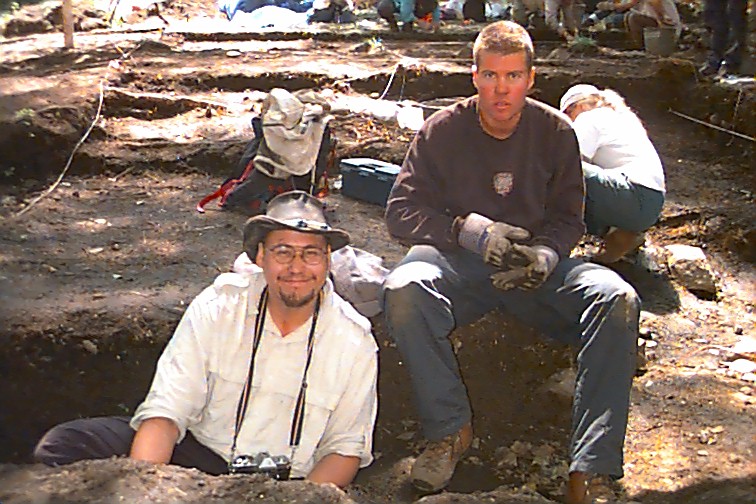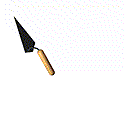'TWAS THE YEAR 1995 AT DhRl
16.....
THE SITE
Back on track again
at the site. Things got rolling quickly.
With two years growth of
grass, stinging nettle and
small trees, we really had
to work !
But it was well worth it,
the site was as beautiful as ever.
The water still swished
right beside the site, like it had never even
noticed us being gone.
Actually, if rivers had mouths (well,
mouths that could talk!),
it probably would not have
said much. It had
seen people coming and going from this
site for so many years that
one year was no big deal, I mean
people have been coming
and going there for over a thousand years!
WHAT DO WE ALREADY KNOW?
Well, we know from the 1993
excavation, when we dug the
big trench, that beneath
the surface of the site are the remains
of houses. We know this
because we can see the house floors
where the earth is really
packed down and has no rocks.
 WHAT DO WE WANT TO KNOW?
Now we are interested in
finding out more about these houses.
As old houses fell down
or burned did the First Nations people
who lived here build new
houses right on top of the old ones?
Or was there the remains
of only one house on each flat terrace?
WHAT DID WE DO?
We know from previous archaeological
excavation and research
in many parts of the world
we often find houses that were built one
over the other for many
generations of families.
When one fell down, another
was built over top of it.
Because of this, we hypothesized,
that the houses at the site
would have been built one
on top of the other.
We could see in the trench
that we first excavated in 1993
and continued excavating
this season that
there was 'layers'.
If you stood in the trench
and looked at the soil on
both sides of you, you would be
able to see different layers.
WHAT DO WE WANT TO KNOW?
Now we are interested in
finding out more about these houses.
As old houses fell down
or burned did the First Nations people
who lived here build new
houses right on top of the old ones?
Or was there the remains
of only one house on each flat terrace?
WHAT DID WE DO?
We know from previous archaeological
excavation and research
in many parts of the world
we often find houses that were built one
over the other for many
generations of families.
When one fell down, another
was built over top of it.
Because of this, we hypothesized,
that the houses at the site
would have been built one
on top of the other.
We could see in the trench
that we first excavated in 1993
and continued excavating
this season that
there was 'layers'.
If you stood in the trench
and looked at the soil on
both sides of you, you would be
able to see different layers.
 It might help to think of
it like a big chocolate cake!
There would be the cake
and then there might be layers of fudge
in the middle. You
could see that the thin layers of fudge are not cake.
This is sort of how archaeologists
could see the layers in trench.
They didn't look like anything
above or below it (like the fudge).
So, the archaeologists decided
to look very closely at the
layers in the trench.
WHAT DID WE FIND?
By carefully examining the
trench, the archaeologists could see four separate layers. Each layer
was, at one time, a floor surface.
The layers (or house floors)
were made of construction fill, things like
dirt and rocks. All
of these things came from
different places to make
the floor of someone's house.
So our hypothesis was correct!
We know that the houses
were built one on top of the other.
We knew this because the
layers (house floors)
in the trench were right
on top of each other.
Over time, as plants die
and things like houses fall down,
the soil builds up, because
of this, we know that the
house floor that is closest
to the surface of the ground is
the newest and the deepest
layer in the trench is the oldest.
When we look at layers in
this way, it is called stratigraphy.
WHY NOT TRY OUT THIS YEAR'S
ACTIVITY
PAGE??
LEARN ALL ABOUT STRATIGRAPHY
BY
DIGGING IN THE DIRT!
It might help to think of
it like a big chocolate cake!
There would be the cake
and then there might be layers of fudge
in the middle. You
could see that the thin layers of fudge are not cake.
This is sort of how archaeologists
could see the layers in trench.
They didn't look like anything
above or below it (like the fudge).
So, the archaeologists decided
to look very closely at the
layers in the trench.
WHAT DID WE FIND?
By carefully examining the
trench, the archaeologists could see four separate layers. Each layer
was, at one time, a floor surface.
The layers (or house floors)
were made of construction fill, things like
dirt and rocks. All
of these things came from
different places to make
the floor of someone's house.
So our hypothesis was correct!
We know that the houses
were built one on top of the other.
We knew this because the
layers (house floors)
in the trench were right
on top of each other.
Over time, as plants die
and things like houses fall down,
the soil builds up, because
of this, we know that the
house floor that is closest
to the surface of the ground is
the newest and the deepest
layer in the trench is the oldest.
When we look at layers in
this way, it is called stratigraphy.
WHY NOT TRY OUT THIS YEAR'S
ACTIVITY
PAGE??
LEARN ALL ABOUT STRATIGRAPHY
BY
DIGGING IN THE DIRT!
Are you getting the hang
of how
archaeological detectives
work?
If yes, click on this eyeball!  If not, well...... click
on it anyway!!!
YOU DESERVE IT!
Well, I don't know about
you, but I am really
curious to find out what
happens next at DhRl 16!
TAKE
ME TO NEXT YEAR!
If not, well...... click
on it anyway!!!
YOU DESERVE IT!
Well, I don't know about
you, but I am really
curious to find out what
happens next at DhRl 16!
TAKE
ME TO NEXT YEAR!





